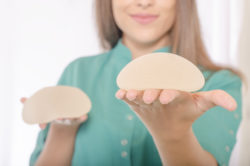Currently, there are two major types of breast implants available: saline implants, which are saltwater or IV-filled implants, or silicone implants, which are filled with silicone gel. Saline implants have been used since 1992, and have provided a very reasonable alternative to breast augmentation when the original silicone implants were removed from the market. However, in 2007, silicone implants were placed back on the market after FDA approval. Since that time, there has been a slow increase in the number of women using silicone implants compared to saline implants for their breast augmentation procedure.
Silicone vs Saline Breast Implants
The main difference between these two implants is the way they feel. The saline implant and silicone implant are essentially identical in their appearance, except at extreme sizes. This means that a very small thin woman using a saline implant is more likely to see rippling on the implant mainly around the edges and in the lower portion of the implant. The saline implant is more palpable, which means you can feel it on the undersurface and the side of the breast. This is the main difference between saline and silicone. Silicone implants are much more natural feeling, which means you essentially cannot feel the breast implant from the outside.
Breast Implant Profiles
There are different profiles, meaning each breast implant has a certain diameter, as well as certain projection or how far the implant sticks out. Depending on a patient’s measurements, a different profile of breast implant may be more appropriate because it fits into the patient’s breast measurements properly, resulting in a more natural appearance.
Breast Implant Surfaces
There are two different surfaces to either silicone or saline breast implants: the smooth round and textured. The smooth round implant, which is the more commonly used implant, does have less rippling and is slightly softer than a textured implant. A textured implant would mainly be used if a patient had developed a capsule with a smooth implant, meaning it has developed a hard scar that causes the implant to feel slightly harder. In almost all situations, the breast implant should be placed beneath the muscle, which avoids or diminishes the slow formation of scar tissue around the implant. It will also camouflage or cover the ripples that are present on the front surface of both silicone and saline implants.
Anatomically-shaped breast implants come in a textured surface. Occasionally the implants can rotate within the breast, causing an abnormal breast shape. If a silicone textured shaped or anatomic implant is used, the gel is much thicker, preventing the rupture of the implant. However, there is an increase in the firmness of the breast. Additionally, the cost of the breast implant is significantly more than the round saline or silicone implants.
Breast Implant Trends
In conclusion, the clear majority of patients now will use a smooth, round saline or silicone implant placed in a submuscular position. The exact dimensions and profile of the breast implant will be determined by the patient’s natural anatomy and what will create the best results. A consultation is necessary to determine the best implant option for you!


